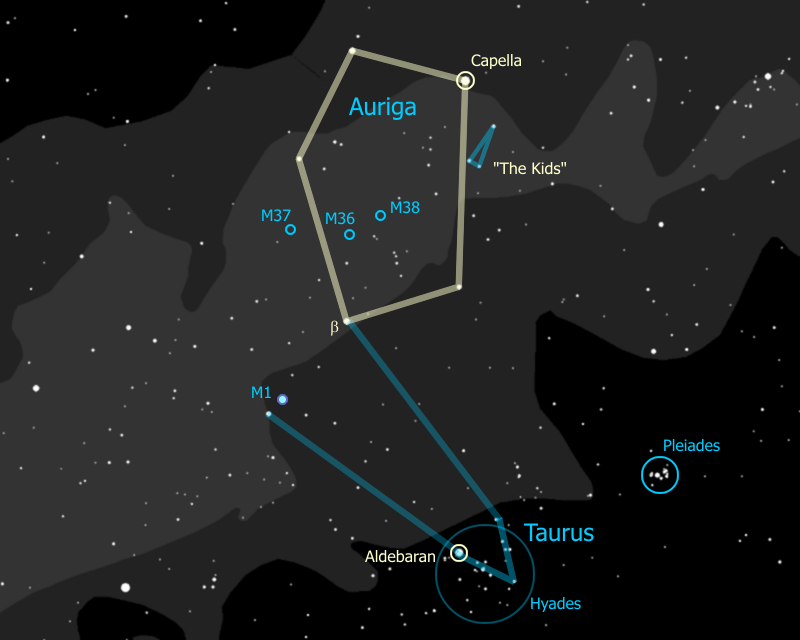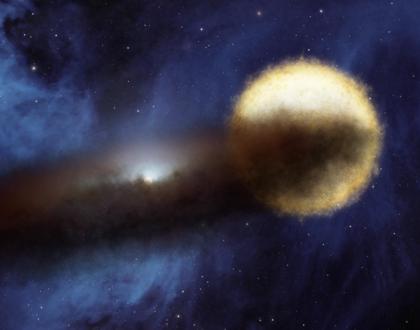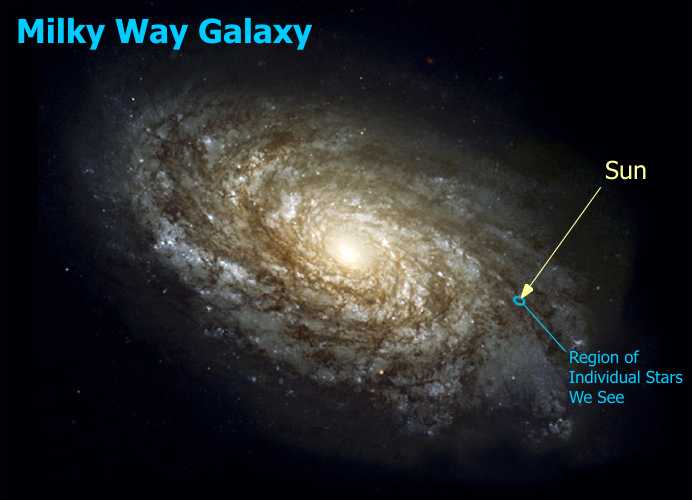Stargazing

|
The Constellation Auriga |

|
We now will follow the two stars across the top of the cup of the
Dipper and cruise westward to the star Capella
in the constellation Auriga.
- Auriga forms a distinctive five-sided figure, and to do so it actually
borrows a star -- β (beta) Tauri which marks
the tip of the Bull's northern horn. {Trace out Auriga}

Auriga is often shown seated and holding a young goat in his arms, represented by the small thin triangle of stars along the right side of the pentangle. These stars are known as "The Kids". The star at the tip of this triangle is ε (epsilon) Aurigae. This is one of the brightest stars in our galaxy, a huge star 2,000 light years away which, every 27 years, is eclipsed by something even huger -- eclipsed for two full years.
The mystery of how this happens may have been solved very recently -- in January of 2010 the theory was presented that ε Aurigae is a dying star, with twice the mass of the sun and blown up to 100 times the diameter of the sun, whose outer shells are being blown off, captured, and formed into a disk by an orbiting companion star. It is this disk, which we are seeing edge on, that is periodically dimming ε Aurigae.
Artist's Conception of Epsilon Aurigae in Eclipse 
- The brightest star in Auriga is "Capella". Part of the reason it's
so bright is because it's pretty close, 45 light years away. That
makes it a little less than half the distance to the Hyades cluster.
In fact, it is moving in space at the same speed in the same direction
as the Hyades, and may be an "outlier" of that group. Another reason
it's so bright is that it is really two stars orbiting one another,
too close for us to see in the telescope. Capella is an important
star for navigation because it's among the brightest stars in the sky,
and because it's so far north that you can see it nearly all year
round.
- The star at Auriga's head, the bright one to the left of Capella, is a
member of the Ursa Major Moving Group.
- Note - we might have the following
discussion any time during the sky tour, whenever it comes up.
Auriga lies right across the Milky Way and therefore contains lots of interesting stars and star clusters. Someone want to tell me what that means -- "The Milky Way"? Where is the Milky Way (someone will always point it out). Most people recognize the Milky Way as a band of light across the night sky, but what is that band of light - where does it come from?
Well it's a bit like looking at a gravel road. Close to you, you can see individual stones, while off in the distance the road merges into a uniform gray. When you look at the Milky Way you are looking at the disk of our galaxy from the inside - the nearby stars you can see individually (most are less than 1,000 light years away), the distant stars merge into a hazy glow. So when you see that band across the sky you are really looking way off into the distance, into the "billions and billions" of stars that make up the disk of our galaxy.

You'll see a similar phenomenon when we look at the more distant galactic clusters. Through binoculars you see them as a hazy patch. When you see them through a telescope - that is, closer up - you can pick out individual stars. The better the telescope, the 'closer' you can get to the cluster, the more stars you can see.

- Because it is the disk of our galaxy that we are seeing, from the inside,
that band of light across the sky is really a hoop -- arcing over us, diving
down below the South horizon, circling around beneath us and coming back up
in the North sky. This side of the hoop has shifted over to the Western sky
and is sweeping toward the horizon. That means that as we look up in that
direction (I'm pointing directly at 31 Comae Berenices) we are looking out
of the disk of our galaxy. And what do we see as we look out of our galaxy,
into outer space, across vast distances? Of course -- other galaxies.
Hundreds of them. Thousands of them. That region right there (my pointer
is sweeping the sky from Corvus to the Dipper) is Galaxy Alley, and we will
get a chance to see at least a few of those other galaxies tonight.
 |
 |
 |
| Back to Polar Constellations | Go to Spring Index | On to Gemini |
Questions
Your questions and comments regarding the Stargazing section are welcome.
You can e-mail the author, Randy Culp for inquiries,
suggestions, new ideas or just to chat.
Updated 09 August 2020
